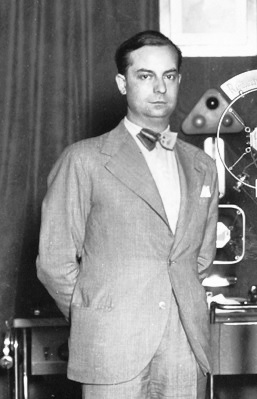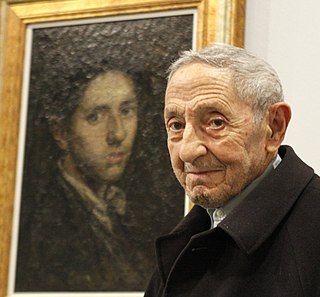
This article needs additional citations for verification .(February 2024) |
Celso Emilio Ferreiro Míguez (1912–1979) was a Galicianist activist, writer, poet, and political journalist.

This article needs additional citations for verification .(February 2024) |
Celso Emilio Ferreiro Míguez (1912–1979) was a Galicianist activist, writer, poet, and political journalist.

Ferreiro was born in Celanova, into a well-off Galicianist family. In 1932, at the age of twenty, he created the Mocedades Galeguistas de Celanova (Galicianist Youths of Celanova) with Xosé Velo Mosquera. In 1934 he also participated in the creation of the Federación de Mocedades Galeguistas (Federation of Galicianist Youths). Some time after this Ferreiro got into trouble because of an article published in his magazine Guieiro.
Ferreiro was mobilized in the Spanish Civil War by the Nationalist troops. He studied law, and contributed to many magazines and newspapers over the period of the Francoist State.
In 1966 Ferreiro travelled to Venezuela, where he collaborated with the Galician Brotherhood. He fell out with the Galician nationalists in Venezuela, and in response published the poetry collection Viaxe ao pais dos ananos (Journey to the land of the dwarves). He founded the Patronato da Cultura Galega (Patronage of Galician Culture), and was part of President Rafael Caldera's cabinet.
After returning to Spain Ferreiro lived in Madrid, where he worked as a journalist. He wrote in Galician and in Castilian, but his most important work was his Galician-language poetry. Ferreiro died in Vigo, Galicia, Spain on 31 August 1979. He was buried in his birth city of Celanova. [1] [2]
A review of his work in 1964 wrote: "It is possible that some poets that write in Castilian - Pablo Neruda, Crémer, Celaya, Hierro, Gloria Fuertes - write about much the same topics that the Galician poet does. But Celso Emilio Ferreiro beats them all, if we ignore Neruda, because he has more poetic talent and because he is more sincere." [3]
The Día das Letras Galegas (Galician Literature Day) was dedicated to Ferreiro in 1989.
His collection of poetry,"Longa noite de pedra" ("Long night of stone"), a lament at the anti-Galician policies of Francoist Spain, [4] is one of the best-known and most powerful works of Galician poetry of all time. One poem from that collection, 'Maria Soliña', has been described as one of the best-known Galician poems of the 20th century. [5]
2012 was officially named 'Year of Celso Emilio Ferreiro' in Galicia in honor of 100 years since his birth. [6]

Alfonso Daniel Manuel Rodríguez Castelao, commonly known as Castelao, was a Galician politician, writer, painter and doctor. He is one of the fathers of Galician nationalism, promoting Galician identity and culture, and was one of the main names behind the cultural movement Xeración Nós. He was also one of the founders and president of the Galicianist Party and had a great influence on the renovating group of Galician art known as Os renovadores. Castelao is considered to be the most important figure in Galician culture of the 20th century.

Ricardo Carballo Calero, self-styled as Ricardo Carvalho Calero from 1981 onward, was a Spanish philologist, academic and writer. He was the first Professor of Galician Language and Literature at the University of Santiago de Compostela. He was a member of the Royal Galician Academy, the Lisbon Academy of Sciences, and also an honorary member of the Galician Language Association. He was one of the main theorists of contemporary Galician reintegrationism and his works on this field are considered a primary reference. Many consider Carballo Calero as one of the most prominent figures of the twentieth century Galician intelligentsia.

Xesús Lorenzo Varela Vázquez was a Galician poet.

Álvaro Cunqueiro Mora was a Galician novelist, poet, playwright, and journalist. He is the author of many works in both Galician and Spanish, including Merlín e familia. He was a cofounder of the Galician Writers Association. In 1991, Galician Literature Day was dedicated to him.

The Partido Galeguista was a Galician party founded in 1978, referring to itself as the historical descendant of the Partido Galeguista in the Second Spanish Republic (1931-1939).

Terra Galega is a coalition of centrist and Galician nationalist political parties; it was established on November 4, 2005; but the name has been registered since May 2005.

Ramón Otero Pedrayo was a Galician geographer, writer and intellectual. He was a key member of the Galician cultural and political movement Xeración Nós.

Alexandre Bóveda Iglesias, commonly known as Alexandre Bóveda, was a Spanish politician and financial officer from Galicia. He is considered one of the most important Galicianist intellectuals during the Spanish Second Republic. He was one of the founders and key member of the Partido Galeguista, origin of contemporary Galician nationalism.

The Statute of Autonomy of Galicia of 1936 was a statute of autonomy for Galicia. It was voted in referendum and presented to the Spanish Parliament. Yet, it could never be implemented because of the Spanish Civil War (1936–1939) and subsequent Francoist Spain (1939–1977). The 1936 statute was drafted by the Partido Galeguista, and it is the historical precedent of the current Statute of Autonomy of Galicia of 1981.
The Partido Galeguista was a Galician nationalist party founded in December 1931. It achieved notoriety during the time of the Spanish Second Republic. The PG grouped a number of historical Galician intellectuals, and was fundamental in the elaboration of the Galician Statute of Autonomy.

Eduardo Modesto Blanco Amor was a Galician writer and journalist who wrote in Galician and in Spanish.

Isaac Díaz Pardo was a Galician intellectual strongly attached to both Sargadelos and Cerámica do Castro.

Acción Galega is a Galician political organization led by former the former member of the PP Rafael Cuíña, former Galician autonomic Minister Teresa Táboas and the former senator of the Galician Nationalist Bloc (BNG) Xosé Manuel Perez Bouza. The party was founded in 2012 through the union of several parties of centrist and moderate Galician nationalist ideology: the Partido Galeguista Demócrata, the Galician Nationalist Party-Galicianist Party, Terra Galega and Galician Coalition.
The Galician Nationalist Party–Galicianist Party was a Galician nationalist and liberal political party, coming from a split of the Galician Coalition. The PNG–PG had 132 members in 2002. Xosé Mosquera Casero was the last secretary general, after the VIII Congress in September 2011. The party merged with Commitment to Galicia in 2012.
The Federación de Mocedades Galeguistas was the youth organization of the Partido Galeguista, which was formed in January 1934, bringing together the different local nationalist youth organizations that had been formed since 1932. It had around 1,000 members, its official organ was the Guieiro, and their leaders were Xaime Illa Couto, Celso Emilio Ferreiro, Xosé Velo and Ramón Piñeiro López.
Mocidades Galeguistas or, also used until 1989, Mocidades Nacionalistas Galegas is a political youth organization of Galicia, with a Galician nationalist and social liberal ideology. The organization defends a liberal Galicia in a federal Spain.

Galician Coalition is a political party in Galicia, Spain with a Galician nationalist and centrist ideology. Since 2012 CG is part of the coalition Compromiso por Galicia.
Ramón Piñeiro López was a Spanish writer and politician who was active in Galicia. He was honored at the 2009 Galician Literature Day.

Manuel María Fernández Teixeiro, better known as Manuel María, was a Spanish poet and academic who wrote in the Galician language. He was notable for his combative character and his political commitment. His poetry touched on themes of love, art, his own political commitment, drawing attention to wrongs, ethnography, physics, history, immateriality, mythology, the animal world, poetic expression, the passing of time, religion, society, language, agricultural labour, urbanism, and geography. The Day of Galician Literature was devoted to him in 2016.
The history of the Galician language can be summarized as seven centuries of normality and five centuries of conflict. From its origins when it separated from the Galician Latin in the 9th century until the introduction of Castilian in the 16th century there was peace, and from the 16th century until the present there were various conflicts.